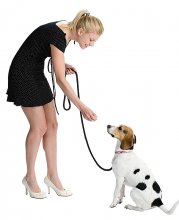No leash dog training
 But off leash obedience takes a lot of hard work, consistency, patience and training.
But off leash obedience takes a lot of hard work, consistency, patience and training.
Off leash obedience is not a skill or a step that is successfully easily taken, off leash obedience is advanced obedience.
If you don’t have great basic obedience at home and when he is on a leash and your dog doesn’t listen to you 95% of the time or more you probably aren’t ready for off leash obedience. For more on getting great obedience on leash click here and here.
I would rather my students strengthen the foundation of their basic obedience skills than skipping ahead to advanced obedience and allowing their dogs to create bad habits. Bad habits are much harder to fix than teaching your dog correct principles and not allowing these bad habits to start.
If your dog learns that you have no control while he is off leash and he begins to reward himself, you are going to have a much harder time training him and getting him to listen than if you build a solid foundation and motivate him to pay attention to you and teach him that you always have control no matter what or where he is.
It is not impossible to change bad habits, but it takes a lot more work. Teaching your dog correct principles and working on obedience is much easier and faster than trying to fix issues and problem solve!
The Very First Thing I do is Teach My Dog Eye Contact and Focus
If my dog is staring up at me and giving me eye contact and I can motivate him to heel in this position I know I have a better chance to achieve off leash results with him.
Most of my dog obedience skills revolve around eye contact and focus!
Safe Place
Next you must find several safe places to train.
Be aware of off leash dog laws and only use spaces where it is legal to unleash your dog or you might be paying a hefty fine!
 Most dogs, when first unsnapped from their leash will bolt and frolic, in the area and the only way to ensure your pet’s safety is to make sure that the area is safe and fenced just in case your dog doesn’t listen.
Most dogs, when first unsnapped from their leash will bolt and frolic, in the area and the only way to ensure your pet’s safety is to make sure that the area is safe and fenced just in case your dog doesn’t listen.
I recommend a fenced baseball field, a tennis court, an empty off leash dog park, or even a friend’s fenced yard.
The first thing I do is unhook my dog and let him enjoy a bit of freedom. Essentially I want to see if he is comfortable being away from me and how far his comfort limit takes him. Some dogs will run as far and fast as they can, but others will dart and wander within 10-30 yards while constantly keeping an eye on you to make sure you don’t leave him.
I, of course, want a dog that cares where I am and does not want to wander too far away from me. As long as the area is safe, I can wander or run in the opposite direction and see if he cares. It is a dismal sign if he doesn’t pay any attention to your actions and it will make your training much more difficult.
Motivating Your Dog
Off leash obedience is all about motivating your dog to pay attention to you and only you.
YOU have to be the most exciting thing in your dog’s environment.
I have seen a number of well trained dogs run away and get hit by cars in an effort to chase other animals or do things that they shouldn’t.
To keep this from happening your dog’s life and love must revolve around you and everything you do! Remember you have to be more exciting than the deer, bunnies, squirrels and kids!
And in order to ensure that I do that to the best of my abilities I play with my dogs as I train them.
Play is fun, it is part of the definition of the word.
You can play and motivate your dog or use great treats, or you can correct and force your dog.
But when your dog is off of his leash he will recognize that to some degree you have lost control, and that he is in control; so force is often not effective.
Having a dog that desires to be with you and consistently listens to you is the most important thing when it comes to trusting him off leash.
Getting Started Off Leash Training
You have found a safe place to train, and you have learned how to play, treat and motivate your dog.
Now it is time to take your dog to the safe place and get started training.
I always hook two leashes to my dog when I get started teaching him about off leash training so that when you unhook leash number one and he thinks he is free, he quickly learns that you are still in control.
We condition our dogs that when they hear and feel the leash being unhooked that they are free to run and play and they no longer have to listen to us.
By using two leashes your dog learns that the unhooking of the leash is not the end of the behavior!
First I start by letting my dog drag his leash so it is there if I need it.
And, then I move to using a long line that is 25 to 50 feet or more, so that I still maintain control.
Keep up with your obedience commands and terms and if your dog does not listen use the dragging leash or put him back on his regular leash and spruce up his understanding.
Off leash obedience can take a while to master and for most of us we excel and then the dog digresses and we must back up in our training; this is normal.
Related posts:

 Training your dog to do advanced tricks like finding something or bringing their food bowl can be done with just 10 minutes a day and some clicker training. It’s…
Training your dog to do advanced tricks like finding something or bringing their food bowl can be done with just 10 minutes a day and some clicker training. It’s… MARY ISENHOUR-LONG Owner - Trainer Photo by Stewart Event Images About The Trainer The phrase, “gone to the dogs”, is certainly an appropriate one to describe my…
MARY ISENHOUR-LONG Owner - Trainer Photo by Stewart Event Images About The Trainer The phrase, “gone to the dogs”, is certainly an appropriate one to describe my… 6 Principles of Successful Training 1. Be Consistent: Apply the same rules and the same words all the time. 2. Be Concise: Give your command just once. Repetition…
6 Principles of Successful Training 1. Be Consistent: Apply the same rules and the same words all the time. 2. Be Concise: Give your command just once. Repetition… Cesar Millan Cesar is a best-selling author, public speaker, and internationally acclaimed star of the TV shows “Dog Whisperer with Cesar Millan, ” “Leader of the…
Cesar Millan Cesar is a best-selling author, public speaker, and internationally acclaimed star of the TV shows “Dog Whisperer with Cesar Millan, ” “Leader of the… At Monument Dog Training, we believe that change is always possible . We regularly resolve aggressive behavioral issues, even with dogs who have been written off…
At Monument Dog Training, we believe that change is always possible . We regularly resolve aggressive behavioral issues, even with dogs who have been written off…